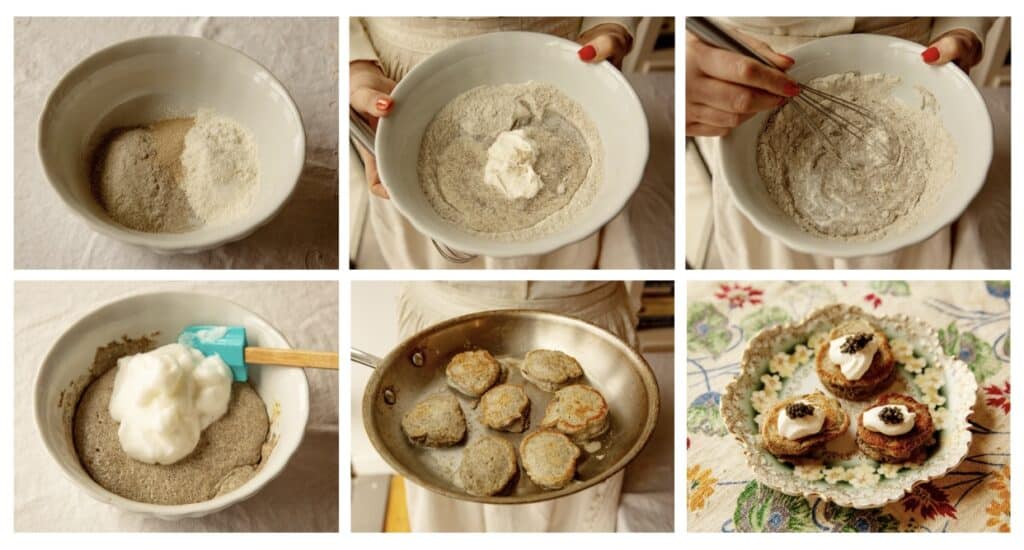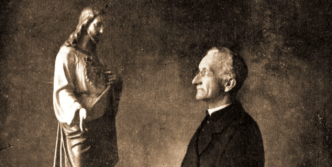This article first appeared in Our Sunday Visitor magazine. Subscribe to receive the monthly magazine here.
A proper French-style Russian blin — not the same as a Russian blini or a French crêpe — is a puffy, meltingly light disc made from a mixture of white and buckwheat flours that’s buttery and crispy on the outside and faintly nutty within. It requires whipped egg whites, a yeast batter, two rises and a special pan to make each little pancake uniform in size and shape. Its most common topping is exquisitely expensive black caviar. This finicky, elevated morsel might not appeal to the home cook, but it should because of its starring role in a story that is profoundly beautiful to the Catholic imagination: “Babette’s Feast,” by Isak Dinesen.
The short story — and later the 1987 cult-classic movie of the same name — tells of a desperate French refugee, Babette, who is taken in by two devout, elderly Lutheran sisters on a remote Norwegian fjord. The sisters were once beauties with the “supernatural fairness of flowering fruit trees or perpetual snow,” but have devoted their lives to quiet living and good works: They keep nothing for themselves and give everything away. Both have passed up glorious worldly romances in favor of the life of faith.
For a special holiday, Babette insists on spending the entirety of a 10,000-franc lottery windfall on cooking “a real French dinner” for the sisters and their community, with transformative results. After eating turtle soup, Blini Demidoff and Cailles en Sarcophage (quail in puff pastry with foie gras and truffles), all accompanied by the finest French wines, the guests realize that “the vain illusions of this earth had dissolved before their eyes like smoke, and they had seen the universe as it really is. They had been given one hour of the millennium.”
The story is very funny: The sisters are scared to have a papist under their roof, and they instruct Babette in how to make local dishes like “split cod” and “ale and bread soup,” unaware that in her former life she was a legendary Parisian chef de cuisine. But it’s often misunderstood as preaching as an embrace of sensuality and earthly pleasure in opposition to the sisters’ dour religion, when nothing could be further from the truth.
Babette may know better than the Protestants how to celebrate God’s gifts in this life, but like the sisters, she gives all she possesses in making the meal, and therein lies its spiritual power. “The world was not a moral, but a mystic concern,” one guest suspects. Another recalls the saying: “The only things which we may take with us from our life on earth are those which we have given away.” I often think of those words when cooking for my family after a hectic day of work (though I wouldn’t make Blini Demidoff for a children’s dinner). Spiritually, we possess only what we give away, whether time, love or food.
The Café Anglais, where the fictional Babette was said to work, was a real French culinary institution at the turn of the 20th century, but the named dish appears to be an invention of Dinesen’s and lives on in recipes on the internet due to the surprising number of fans who have recreated the feast from the movie. I based my recipe on the most authoritative source I could find for French-style Russian blini, the 1938 encyclopedia of gastronomy “Larousse Gastronomique,” edited by Prosper Montaigné with contributions from Georges Auguste Escoffier. I added the contemporary twist of using sour cream instead of whipped cream for the batter, and I adjusted the rising time. I didn’t have the special pan, so my blini didn’t achieve perfect uniformity. I also found making batches of teaspoon-sized pancakes to be extremely slow. But the homemade version of the dish was vastly better than the tasteless styrofoam chips that pass for blini in the supermarket and is feast-worthy indeed.

Blini Demidoff
– 1/2 cup milk
– 1 teaspoon yeast
– Pinch sugar
– 1/2 cup buckwheat flour
– 1/2 cup white flour
– Pinch salt
– 1/3 cup sour cream
– 1 egg yolk
– 2 egg whites
– 2 1/2 tablespoons butter
– Sour cream and black caviar to serve
Makes 40
1. Heat 1/2 cup milk to 110°. Transfer to a medium mixing bowl, then add the yeast and the pinch of sugar and set aside. 2. Whisk together the flours and salt. When the yeast has activated and the yeast mixture is frothy, whisk in the egg yolk and the sour cream. 3. Add the dry ingredients to the wet, stir to combine, cover, and set aside in a warm place for 1 hour until the mixture has doubled in size. 4. Beat the egg whites to stiff peaks, fold into the batter and set aside to rise again for another hour. (The full hour is important here and the final batter should be frothy, not stringy.) 5. Warm 1/2 tablespoon of butter in a skillet on medium heat and drop heaping teaspoons of batter into the pan. Cook until the top of the pancake is covered with bubbles, then flip, adjusting the heat as needed to prevent burning. Repeat, re-buttering the skillet with each batch. 6. Serve warm, topped with sour cream and caviar.







